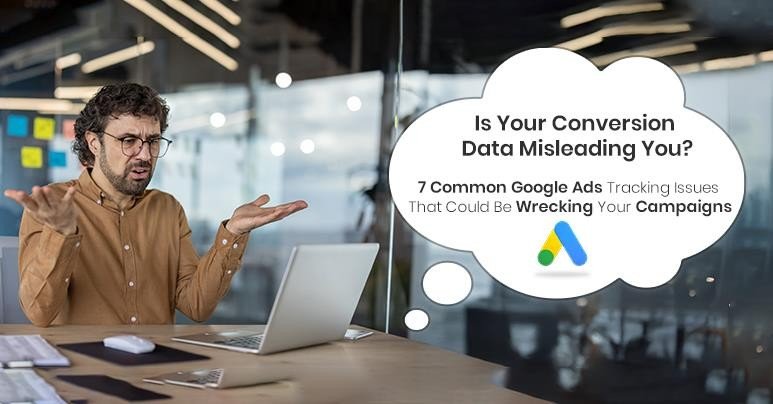Running a Google Ads campaign without accurate conversion tracking is like trying to navigate without a map. Even the well-structured campaigns can deliver poor results if the data guiding them is flawed.
Conversion tracking is often set up once and forgotten—until performance takes a hit. Whether you're looking to improve performance or diagnose underperforming campaigns, the first step should always be the same: check your conversion data.
Accurate data is the foundation of smart advertising. If your conversion tracking is misleading or incomplete, it can lead to poor optimization decisions—like scaling underperforming campaigns, pausing profitable ones, or miscalculating your return on ad spend (ROAS).
Below are seven common Google Ads tracking issues that can cause inaccurate or inconsistent conversion data—and how to fix them.
1. Conversion Tracking Isn’t Set Up Properly
One of the most common issues in Google Ads is improperly configured tracking. Conversions may be missed, duplicated, or firing in the wrong place.
For example, tracking a thank-you page that reloads on refresh can lead to multiple conversions being recorded for a single user action. This creates inflated data that misguides performance analysis.
How to Fix It:
• Clearly define conversion actions in your Google Ads account.
• Use Google Tag Manager (GTM) to centralize tracking setup.
• Verify tags with Google’s Tag Assistant or GTM’s Preview Mode.
2. Tracking Low-Value or Secondary Conversions
Not all user actions hold the same value. Actions like scroll depth, video views, or time on site may offer useful insights but shouldn't be treated as primary conversion events.
When these secondary metrics are used as optimization signals, budgets may be directed toward actions that don’t actually generate leads or sales.
How to Fix It:
• Focus on high-intent actions like purchases, phone calls, and form submissions.
• Use secondary metrics for user behavior insights, not for performance optimization.
3. Data Discrepancies between Google Ads and GA4
It’s common to see differences in conversion data between Google Ads and Google Analytics 4 (GA4). These discrepancies are usually due to different attribution models, reporting windows, or event configurations.
How to Fix It:
• Link your Google Ads and GA4 accounts correctly.
• Align attribution models (e.g., data-driven, last-click) across both platforms.
• Ensure conversion events are consistently defined in both systems.
4. GCLID Is Missing or Broken
The Google Click Identifier (GCLID) allows Google Ads to connect a conversion back to the original ad click. If it’s stripped from URLs—often by redirects, third-party forms, or URL shorteners—conversions can’t be attributed properly.
How to Fix It:
• Enable auto-tagging in your Google Ads account.
• Ensure the GCLID is preserved throughout the user journey, especially on forms and multi-page experiences.
• Work with developers to troubleshoot integration issues with CRMs or custom landing pages.
5. Privacy Settings and Consent Mode Are Blocking Data
With increasing privacy regulations like GDPR, many users opt out of tracking cookies. When this happens, Google’s tags may not fire—resulting in untracked conversions.
How to Fix It:
• Implement Google Consent Mode to adjust tag behavior based on user permissions.
• Consider using server-side tagging and first-party data strategies to retain visibility.
• Understand that modeled conversions may take time to populate and aren’t a complete substitute for full tracking.
6. Offline Conversions Are Delayed or Missing
Conversions that happen offline—such as over the phone or in-store—can be tracked in Google Ads but are often not uploaded correctly or consistently.
How to Fix It:
• Regularly upload offline conversions (daily or weekly).
• Include required identifiers such as GCLID and timestamps.
• Monitor upload results in Google Ads for any errors or mismatches.
7. Tagging Conflicts or Technical Errors
Even with a solid strategy, technical issues can stop conversion events from firing. Conflicting scripts, outdated plugins, or incorrect tag placements are common culprits.
How to Fix It:
• Audit your setup regularly using Tag Assistant or GTM Preview Mode.
• Minimize the use of conditional loading where possible.
• Coordinate closely with your development team, especially when integrating with other platforms like Meta, HubSpot, or Salesforce.
Final Thoughts
Conversion tracking is more than just a technical setup—it’s a strategic necessity. Inaccurate or incomplete data can undermine even the well-optimized campaigns.
By auditing you’re tracking systems regularly and addressing these common issues, you can ensure that your campaigns are guided by clean, reliable data. This will lead to more informed decisions, better campaign performance, and a clearer understanding of what truly drives results in your Google Ads account.
Before making any changes to your campaigns—check your tracking. Accurate data is the foundation of successful digital advertising.





